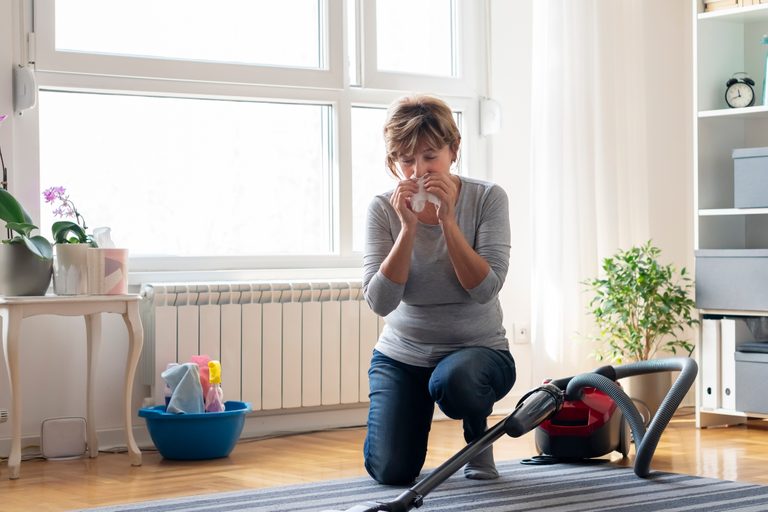4 Allergist-Approved Ways to Get Rid of Dust Mites

What are dust mites?
You can't see 'em, but if you're allergic to dust mites—and 20 million Americans are—these tiny buggers can certainly create a lot of misery.
Fortunately, kicking them out of their comfort zones by dust-mite proofing your home can go a long way toward improving sniffling, sneezing, and other dust mite allergy symptoms.
A dust mite is only about one-quarter to one-third of a millimeter in size. Under a microscope, they look like white bugs, and they have eight legs.
Dust mites are not considered parasites because they don't bite, but they do chow down on dead human skin cell flakes.
Ready for a gross-out fact? On average, adults shed up to 1.5 grams of skin each day. This can feed 1 million dust mites, according to the Asthma and Allergy Foundation of America (AAFA).
Where do dust mites live?
These pesky bugs make themselves at home in your bedding, mattresses, upholstered furniture, carpets, curtains, and even your kid's favorite teddy bear. And the news just keeps getting better: dust mites are ubiquitous.
Roughly four out of five homes in the United States have detectable levels of dust mite allergen in at least one bed, according to the American Lung Association.
Dust mites thrive in temperatures of 68 to 77 degrees Fahrenheit and prefer humidity. They don't drink water, so they absorb moisture from the air. If it's not humid, they won't survive or thrive.
A dust mite starts off as an egg and develops into an adult over the course of a month, provided the temperature and humidity level in your home is just right, according to entomologists who study bugs at the University of Kentucky in Lexington.
They can live up to two months, and female dust mites lay about 100 eggs during their life spans.
And dust mites are always in season, says Stephen I. Wasserman, MD, an allergist and immunologist in La Jolla, California, and a spokesperson for the American Academy of Allergy, Asthma, and Immunology.
"If you are allergic to dust mites, you will have the symptoms relatively regularly," he says.
Geography makes a difference, though.
"If you live in a place that is high, dry, and cold, there will be fewer dust mites," says Dr. Wasserman.
Dust mite allergy symptoms
"Dust mites cause allergy by inhalation of their microscopic fecal matter and dead body parts, which are allergens," explains Neeta Ogden, MD, an allergist and immunologist in Edison, New Jersey, and a spokesperson for the American College of Allergy, Asthma, and Immunology.
Yep, it's pretty gross. And it's why you might have allergies outside spring and fall allergy seasons.
"This can lead to a more chronic allergy picture," Dr. Ogden says. "Year-round nasal congestion is classic for dust mite allergy."
The itchy, irritated skin of eczema is also tied to dust mite allergy. Other symptoms of dust mite allergy can include sneezing, sniffling, itchy eyes, and/or cough.
An allergy to dust mites may also cause or worsen asthma. These symptoms include difficulty breathing, wheezing, coughing, shortness of breath, chest pain or tightness, and difficulty talking. And it can lead to a severe asthma attack.
Overall, if you have a dust mite allergy, you'll likely notice your skin become red and itchy.
Diagnosing a dust mite allergy
Your doctor can diagnose dust mite allergy by asking about your symptoms and when they occur.
Skin prick and/or blood testing can also help confirm that dust mites are driving these symptoms, Dr. Wasserman says.
The skin prick test is the gold standard allergy test, and it's way less painful than it sounds. Your doctor will apply to your skin a drop of liquid containing a small portion of the allergen. Pricks to the skin get the allergen into your system.
After about 15 minutes, if your skin has a reaction, you'll likely have a large welt in that area with the possibility of redness and itching.
A blood test may not be as accurate since it can only pick up on antibodies for the allergy.
Treating a dust mite allergy
Since you can't totally get rid of or avoid dust mites, treating your symptoms will help reduce some of your misery.
Immunotherapy, or allergy shots, gradually introduce small amounts of an allergen—in this case, dust mites—to your immune system in the hopes that it begins to recognize them without going into attack mode.
Other treatments are aimed at symptoms, Dr. Wasserman explains.
If you are sniffling and sneezing, an over-the-counter antihistamine (like Allegra and Claritin) can help.
If your eyes are itchy, then eye drops (such as Visine and Refresh) are available. And if dust mites trigger your asthma, your doctor can prescribe an inhaler and other treatments to make you feel better.
How to get rid of dust mites
Hard truth: dust mites are hard to completely eliminate.
"Dust mites are an inevitable part of our homes and live in the fibers of bedding and upholstery—think mattresses, pillows, comforters, and carpets," says Dr. Ogden.
But you can take steps to reduce your exposure and minimize your symptoms. That starts with closing off access to their favorite hiding spots.
Get dust-mite-proof covers
To block their access to your bed, invest in mattress and pillow covers that are specially designed to keep dust mites out.
A 2018 study in The Journal of Allergy and Clinical Immunology: In Practice found that finely woven fabrics keep dust mites out.
Use hot water
When it's time to wash your bedding, use hot water to kill the dust mites.
"Wash sheets in hot water and hot dryer cycle once a week to kill off residual dust mite particulate matter," Dr. Ogden says.
You can do the same for beloved stuffed animals. If the stuffed animal is too precious to wash, place it in a plastic bag in your freezer for 24 hours, as this will also kill the dust mites.
Choose different decor
Consider getting rid of carpet and opting for hardwood floors or area rugs instead.
"Hard surfaces can be cleaned better than wall-to-wall carpet," Dr. Ogden says. "Use rugs that can be regularly thrown in the wash."
It's also a good idea to skip fabric drapes and headboards, which can harbor mites. Instead, choose blinds and furniture you can wipe down, she says.
Get a HEPA filter
High-efficiency particulate air (HEPA) filters can help get dust mites and other allergens out of the air, says Karin Pacheco, MD, an allergist and associate professor in the division of environmental and occupational health sciences at National Jewish Health in Denver.
Use a local HEPA unit that you can move from room to room—these are some of the best portable air purifiers.
Vacuum regularly with a HEPA-certified vacuum so dust and allergens stay in the vacuum, Dr. Ogden suggests. Not sure where to find one? Experts say these are six great HEPA filter vacuums for people with allergies.
If you can pass the cleaning job off to someone without a dust mite allergy, go for it, says the AAFA. If you don't have takers, wear a mask when dusting or vacuuming.
The post 4 Allergist-Approved Ways to Get Rid of Dust Mites appeared first on The Healthy

